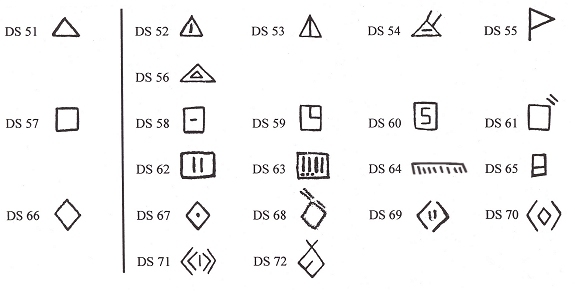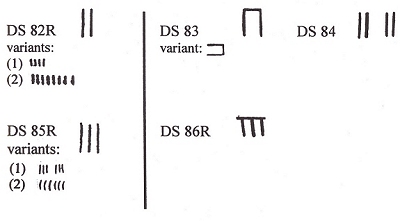

Patrocinio del
Comune di Roma
Dipartimento XIV
Comune di Roma
Dipartimento XIV
by Shan M. M. Winn
Triangles, rectangles and lozenges all appear to identify a goddess in her fertile, life-giving function; therefore, they may also be related to the pubic triangle and the V sign. The rectangle, the use of which has been compared with the Egyptian cartouche, generally contains two parallel short lines that are thought to be associated with the "goddess," perhaps as one of her defining qualities. Occasionally a short line is placed within the sign, possibly symbolizing seed or fertility. Core signs 
Several interesting sign clusters are composed of two or more signs - including a V sign or a whirl symbol - joined to 2, 3 or 4 lines. DS 76-81 are inscribed on ritual objects. 
Two parallel lines (DS 82R; R=Ritual) that frequently have a diagonal orientation are found on numerous female figurines and may symbolize an attribute, such as the power that is associated with a deity. In particular, a goddess may be called upon to bestow a blessing or grant a wish. This is suggested by the use of two parallel lines on numerous spindle whorls as probable invocations of a goddess in rituals of magic and divination, whereas the presence of two lines together with a V sign on figurines evokes a request for reproductive fertility. Occasionally two lines are repeated, giving the appearance of a sign or symbol composed of four lines, but these examples should be understood as a pair of two lines, i.e., two and two, not four. This appears to apply to two lines in the use of script; the doubling of two lines on spindle whorls, for example, may also appear in an inscription as four lines. Reduplication intensifies an invocation as well as devotion to a deity. Gimbutas described this force as the "The Power of Two", or the power of doubling. The Great Goddess seems to have been associated with powers that involve the number 2 and its doubles, or reduplications. Two-headed figurines may also be an expression of the Power of Two or symbolize an aspect of the Great Goddess. Two lines joined together by a bar may represent the quality of twinning. Twins are frequently considered to be special symbols of fertility, abundance or good fortune. Through time the desirable features of two lines likely tended to symbolize the goddess herself, not just her power. Then the double line would have served as a logogram indicating the presence of a deity. Three parallel lines (DS 85R) are found on both figurines and spindle whorls and, according to Gimbutas, symbolize the Bird Goddess. However, if a bar connects the three lines, thereby joining them into one sign (DS 86R), then a triple source of power or triple aspect goddess may be indicated. A doubling of the three lines - shown either as six lines or as two groups of three lines - may reflect a ritual method of invoking the Bird Goddess. Six parallel lines appear on a number of female figurines. The common occurrence of two, three, four or six parallel lines on both figurines and spindle whorls signals their link with the goddess and calls to mind a possible use of numerology for ritual purposes. The ritual use of 2, 3, 4 or 6 lines may reflect the importance of these "lucky" numbers in a duodecimal system (based on twelve) or a sexagesimal system (based on 60). Core signs  | ||||||
| 1 | 2 | 3 | 4 | 5 |